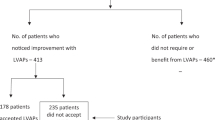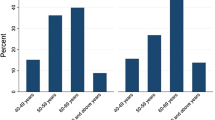Abstract
Background/Objectives
To report the impact of interventions for avoidable vision impairment (VI) on the visual function of elderly residents in ‘homes for the aged’ in India.
Methods
Participants aged ≥60 years were recruited. A comprehensive eye examination was conducted by trained examiners and interventions were provided. Trained social investigators administered the Indian Vision Function questionnaire (INDVFQ) to assess visual function before and after the intervention (spectacles, cataract surgery or laser capsulotomy). Lower scores on IVFQ imply better visual function. VI was defined as presenting visual acuity worse than 6/18 in the better eye. VI due to cataract, uncorrected refractive errors, and posterior capsular opacification after cataract surgery were considered avoidable VI.
Results
The mean age of the participants (n = 613) was 73.8 years (standard deviation: 8.1 years) and 378 (62.2%) were women. 64/103 (62.1%) participants who had avoidable VI at baseline were evaluated after the intervention. Significant gains were observed in all four domains of visual function. There was a 14.9% improvement in mobility scores (33.8 versus 28.8; p = 0.03), a 19.9% improvement in the activity limitations score (36.8 versus 29.5; p < 0.01), a 10.9% improvement in the psychosocial impact score (41.1 versus 36.6; p < 0.01) and a 13.6% improvement in the visual symptoms score (49.2 versus 42.5 p < 0.01). Overall, the mean IVFQ score improved by 16.4% (47.6 versus 39.8; p < 0.01).
Conclusion
Elderly individuals in residential care with avoidable VI had a significant improvement in visual function after relatively low-cost interventions such as spectacles and cataract surgery. Strategies are needed to provide these interventions for the elderly in ‘homes for the aged’ in India.
This is a preview of subscription content, access via your institution
Access options
Subscribe to this journal
Receive 18 print issues and online access
$259.00 per year
only $14.39 per issue
Buy this article
- Purchase on Springer Link
- Instant access to full article PDF
Prices may be subject to local taxes which are calculated during checkout

Similar content being viewed by others
Data availability
The datasets generated during and/or analysed during the current study are available from the corresponding author on reasonable request.
References
Bourne R, Steinmetz JD, Flaxman S, Briant PS, Taylor HR, Resnikoff S, et al. Trends in prevalence of blindness and distance and near vision impairment over 30 years: an analysis for the Global Burden of Disease Study. Lancet Glob Health. 2021;9:e130–43.
Steinmetz JD, Bourne RRA, Briant PS, Flaxman SR, Taylor HRB, Jonas JB, et al. Causes of blindness and vision impairment in 2020 and trends over 30 years, and prevalence of avoidable blindness in relation to VISION 2020: the Right to Sight: an analysis for the Global Burden of Disease Study. Lancet Glob Health. 2021;9:e144–60.
Mitchell P, Hayes P, Wang JJ. Visual impairment in nursing home residents: the Blue Mountains Eye Study. Med J Aust. 1997;166:73–76.
Owsley C, McGwin G, Scilley K, Meek GC, Dyer A, Seker D. The visual status of older persons residing in nursing homes. Arch Ophthalmol. 2007;125:925–30.
Sinoo MM, Kort HS, Duijnstee MS. Visual functioning in nursing home residents: information in client records. J Clin Nurs. 2012;21:1913–21.
Eichenbaum JW, Burton WB, Eichenbaum GM, Mulvihill M. The prevalence of eye disease in nursing home and non-nursing home geriatric populations. Arch Gerontol Geriatrics. 1999;28:191–204.
Evans BJ, Rowlands G. Correctable visual impairment in older people: a major unmet need. Ophthalmic Physiol Opt. 2004;24:161–80.
Foran S, Rose K, Wang JJ, Mitchell P. Correctable visual impairment in an older population: the blue mountains eye study. Am J Ophthalmol. 2002;134:712–9.
Fung MM, Yap M, Cheng KK. Correctable visual impairment among people with diabetes in Hong Kong. Clin Exp Optom. 2010;93:453–7.
Hollands H, Brox AC, Chang A, Adilman S, Chakraborti B, Kliever G, et al. Correctable visual impairment and its impact on quality of life in a marginalized Canadian neighbourhood. Can J Ophthalmol. 2009;44:42–48.
Lamoureux EL, Fenwick E, Moore K, Klaic M, Borschmann K, Hill K. Impact of the severity of distance and near-vision impairment on depression and vision-specific quality of life in older people living in residential care. Invest Ophthalmol Vis Sci. 2009;50:4103–9.
Varma R, Wu J, Chong K, Azen SP, Hays RD, Los Angeles Latino Eye Study G. Impact of severity and bilaterality of visual impairment on health-related quality of life. Ophthalmology. 2006;113:1846–53.
Jacobs JM, Hammerman-Rozenberg R, Maaravi Y, Cohen A, Stessman J. The impact of visual impairment on health, function and mortality. Aging Clin Exp Res. 2005;17:281–6.
Marmamula S, Mitchell W, Zebardast N, Locascio J, Barrenkala NR, Kumbham TR, et al. Impact of vision loss on visual function among elderly residents in the “Home for the Aged” in India: the hyderabad ocular morbidity in elderly study. Transl Vis Sci Technol. 2020;9:11.
Snyder CF, Jensen RE, Segal JB, Wu AW. Patient-reported outcomes (PROs): putting the patient perspective in patient-centered outcomes research. Med Care. 2013;51:S73–79.
Marmamula S, Ravuri CS, Boon MY, Khanna RC. A cross-sectional study of visual impairment in elderly population in residential care in the South Indian state of Andhra Pradesh: a cross-sectional study. BMJ Open. 2013;3:e002576.
Mane AB. Ageing in India: some social challenges to elderly care. J Gerontol Geriatr Res. 2016;5:e136.
Yeolekar ME. Elderly in India-needs and issues. J Assoc Physicians India. 2005;53:843–4.
Marmamula S, Barrenakala NR, Challa R, Kumbham TR, Modepalli SB, Yellapragada R, et al. Prevalence and risk factors for visual impairment among elderly residents in ‘homes for the aged’ in India: the Hyderabad Ocular Morbidity in Elderly Study (HOMES). Br J Ophthalmol. 2021;105:32–36.
Marmamula S, Barrenkala NR, Challa R, Reddy K T, Yellapragada S, Brahmanandam M S, et al. Hyderabad ocular morbidity in elderly study (HOMES) - rationale, study design and methodology. Ophthalmic Epidemiol. 2020;27:83–92.
Ganguli M, Ratcliff G, Chandra V, Sharma S, Gilby J, Pandav R, et al. A Hindi version of the MMSE: the development of a cognitive screening instrument for a largely illiterate rural elderly population in India. Int J Geriatr psychiatry. 1995;10:367–77.
Gothwal VK, Bagga DK, Sumalini R. Rasch analysis of the Indian vision function questionnaire. Br J Ophthalmol. 2012;96:619–23.
Finger RP, Kupitz DG, Holz FG, Balasubramaniam B, Ramani RV, Lamoureux EL, et al. The impact of the severity of vision loss on vision-related quality of life in India: an evaluation of the IND-VFQ-33. Invest Ophthalmol Vis Sci. 2011;52:6081–8.
Gupta SK, Viswanath K, Thulasiraj RD, Murthy GV, Lamping DL, Smith SC, et al. The development of the Indian vision function questionnaire: field testing and psychometric evaluation. Br J Ophthalmol. 2005;89:621–7.
Murthy GV, Gupta SK, Thulasiraj RD, Viswanath K, Donoghue EM, Fletcher AE. The development of the Indian vision function questionnaire: questionnaire content. Br J Ophthalmol. 2005;89:498–503.
Mitchell W, Marmamula S, Zebardast N, Ng W, Locascio JJ, Kumbam T, et al. Psychometric validation techniques applied to the IND-VFQ-33 visual function questionnaire: the Hyderabad ocular morbidity in the elderly study (HOMES). BMC Med Res Methodol. 2021;21:26.
Nutheti R, Shamanna BR, Nirmalan PK, Keeffe JE, Krishnaiah S, Rao GN, et al. Impact of impaired vision and eye disease on quality of life in Andhra Pradesh. Invest Ophthalmol Vis Sci. 2006;47:4742–8.
Nirmalan PK, Tielsch JM, Katz J, Thulasiraj RD, Krishnadas R, Ramakrishnan R, et al. Relationship between vision impairment and eye disease to vision-specific quality of life and function in rural India: the Aravind Comprehensive Eye Survey. Invest Ophthalmol Vis Sci. 2005;46:2308–12.
Marmamula S, Barrenkala NR, Khanna RC, Challa R, Bhakki M, Kumbham TR, et al. Near vision impairment among the elderly in residential care-the Hyderabad Ocular Morbidity in Elderly Study (HOMES). Eye (Lond). 2021;35:2310–15.
Nutheti R, Keeffe JE, Shamanna BR, Nirmalan PK, Krishnaiah S, Thomas R. Relationship between visual impairment and eye diseases and visual function in Andhra Pradesh. Ophthalmology. 2007;114:1552–7.
Zebardast N, Swenor BK, van Landingham SW, Massof RW, Munoz B, West SK, et al. Comparing the Impact of Refractive and Nonrefractive Vision Loss on Functioning and Disability: The Salisbury Eye Evaluation. Ophthalmology. 2015;122:1102–10.
Oliver JE, Thulasiraj RD, Rahmathullah R, Baburajan, Katz J, Tielsch JM, et al. Vision-specific function and quality of life after cataract extraction in south India. J Cataract Refract Surg. 1998;24:222–9.
Finger RP, Kupitz DG, Fenwick E, Balasubramaniam B, Ramani RV, Holz FG, et al. The impact of successful cataract surgery on quality of life, household income and social status in South India. PLoS One. 2012;7:e44268.
Vignesh D, Gupta N, Kalaivani M, Goswami AK, Nongkynrih B, Gupta SK. Prevalence of visual impairment and its association with vision-related quality of life among elderly persons in a resettlement colony of Delhi. J Fam Med Prim care. 2019;8:1432–9.
Marmamula S, Kumbham TR, Modepalli SB, Chakrabarti S, Keeffe JE. Barriers to uptake of referral eye care services among the elderly in residential care: the Hyderabad Ocular Morbidity in Elderly Study (HOMES). Br J Ophthalmol. 2022;1:bjophthalmol-2021-320534.
Marmamula S, Kumbham TR, Modepalli SB, Chakrabarti S, Keeffe JE. Barriers to uptake of referral eye care services among the elderly in residential care: the Hyderabad Ocular Morbidity in Elderly Study (HOMES). Br J Ophthalmol. 2022;1:bjophthalmol-2021-320534.
Marmamula S, Yanamala NK, Khanna RC. “Eyecare on call” - Extending the frontiers of care through home-based eye care - Concept and the protocol. Indian J Ophthalmol. 2020;68:2625–7.
Acknowledgements
The authors thank the study participants for their committed contribution, Mr. Rajesh Challa and Ms. Madhuri Bhakki for their assistance in data collection, Ms. Muni Rajya Lakshmi for her support in data management, and Prof. Jill E. Keeffe (L V Prasad Eye Institute) for her inputs on earlier versions of the manuscript. Authors thank Ms. Neha Hassija for their language inputs on earlier versions of the manuscript.
Funding
This work was supported by Wellcome Trust/DBT India Alliance Fellowship [IA/CPHE/14/1/501506] awarded to Dr. Srinivas Marmamula and Hyderabad Eye Research Foundation (HERF), India.
Author information
Authors and Affiliations
Contributions
Study concept and design: SM. Acquisition, analysis, or interpretation of data: SM, TRK, SBM, RY. Drafting of the manuscript: SM. Critical revision of the manuscript for important intellectual content: SM, RCK, DSF. Statistical analysis: SM
Corresponding author
Ethics declarations
Competing interests
The authors declare no competing interests.
Additional information
Publisher’s note Springer Nature remains neutral with regard to jurisdictional claims in published maps and institutional affiliations.
Supplementary information
Rights and permissions
Springer Nature or its licensor holds exclusive rights to this article under a publishing agreement with the author(s) or other rightsholder(s); author self-archiving of the accepted manuscript version of this article is solely governed by the terms of such publishing agreement and applicable law.
About this article
Cite this article
Marmamula, S., Barrenkala, N.R., Kumbham, T.R. et al. Impact of an intervention for avoidable vision loss on visual function in the elderly–The Hyderabad Ocular Morbidity in Elderly Study (HOMES). Eye 37, 1725–1731 (2023). https://doi.org/10.1038/s41433-022-02229-6
Received:
Revised:
Accepted:
Published:
Issue Date:
DOI: https://doi.org/10.1038/s41433-022-02229-6



